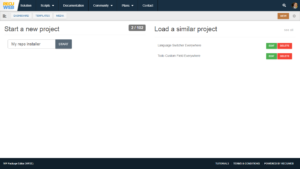
A standardized, organized, object-oriented foundation for building high-quality WordPress Plugins.
Features
- The Boilerplate is based on the Plugin API, Coding Standards, and Documentation Standards.
- All classes, functions, and variables are documented so that you know what you need to change.
- The Boilerplate uses a strict file organization scheme that corresponds both to the WordPress Plugin Repository structure, and that makes it easy to organize the files that compose the plugin.
- The project includes a
.potfile as a starting point for internationalization.
Recommended Tools
i18n Tools
The WordPress Plugin Boilerplate uses a variable to store the text domain used when internationalizing strings throughout the Boilerplate. To take advantage of this method, there are tools that are recommended for providing correct, translatable files:
Any of the above tools should provide you with the proper tooling to internationalize the plugin.
License
The WordPress Plugin Boilerplate is licensed under the GPL v2 or later.
This program is free software; you can redistribute it and/or modify it under the terms of the GNU General Public License, version 2, as published by the Free Software Foundation.
This program is distributed in the hope that it will be useful, but WITHOUT ANY WARRANTY; without even the implied warranty of MERCHANTABILITY or FITNESS FOR A PARTICULAR PURPOSE. See the GNU General Public License for more details.
You should have received a copy of the GNU General Public License along with this program; if not, write to the Free Software Foundation, Inc., 51 Franklin St, Fifth Floor, Boston, MA 02110-1301 USA
A copy of the license is included in the root of the plugin’s directory. The file is named LICENSE.
Important Notes
Licensing
The WordPress Plugin Boilerplate is licensed under the GPL v2 or later; however, if you opt to use third-party code that is not compatible with v2, then you may need to switch to using code that is GPL v3 compatible.
For reference, here’s a discussion that covers the Apache 2.0 License used by Bootstrap.
Includes
Note that if you include your own classes, or third-party libraries, there are three locations in which said files may go:
plugin-name/includesis where functionality shared between the admin area and the public-facing parts of the site resideplugin-name/adminis for all admin-specific functionalityplugin-name/publicis for all public-facing functionality
Note that previous versions of the Boilerplate did not include Plugin_Name_Loader but this class is used to register all filters and actions with WordPress.
The example code provided shows how to register your hooks with the Loader class.
What About Other Features?
The previous version of the WordPress Plugin Boilerplate included support for a number of different projects such as the GitHub Updater.
These tools are not part of the core of this Boilerplate, as I see them as being additions, forks, or other contributions to the Boilerplate.
The same is true of using tools like Grunt, Composer, etc. These are all fantastic tools, but not everyone uses them. In order to keep the core Boilerplate as light as possible, these features have been removed and will be introduced in other editions, and will be listed and maintained on the project homepage.
Credits
The WordPress Plugin Boilerplate was started in 2011 by Tom McFarlin and has since included a number of great contributions. In March of 2015 the project was handed over by Tom to Devin Vinson.
The current version of the Boilerplate was developed in conjunction with Josh Eaton, Ulrich Pogson, and Brad Vincent.
The homepage is based on a design as provided by HTML5Up, the Boilerplate logo was designed by Rob McCaskill of BungaWeb, and the site favicon was created by Mickey Kay.
Documentation, FAQs, and More
If you’re interested in writing any documentation or creating tutorials please let me know .
Setup a Dev environment
After filling the plugin information and settings, deploy the Boilerplate script and its dependencies in a dev environment following these steps:
1 – Make sure you keep the “Installer” option checked when downloading the archive from the previous steps.
2 – Install the plugin package installer locally and activate the plugin from the list.
3 – Click the new “Dependencies & Licenses” link under the section Plugins of the admin dashboard. You should see 3 elements:
- the activated WP Boilerplate Installer (#id)
- the actual Boilerplate Script named with your project title
- other dependencies previously selected via the WP2E panel
4 – Install and activate all missing scripts.
- Give a name to your project
- Download the Installer Package
- Install & activate the plugin locally
- Install the suggested dependencies
Note: The package installer can be deleted once all dependencies are successfully installed




